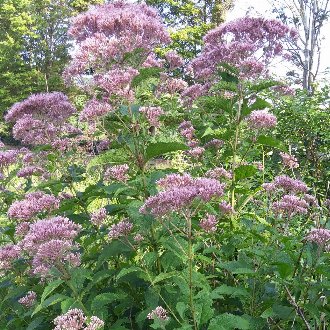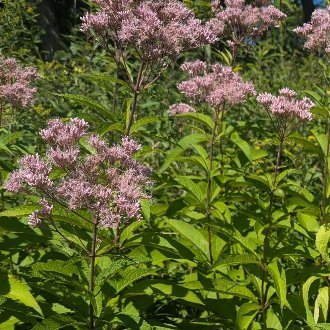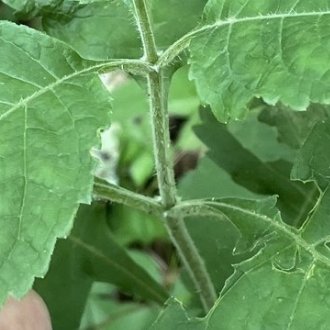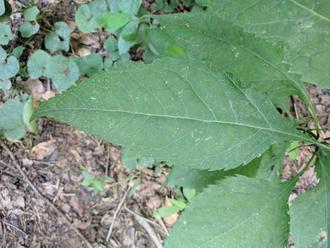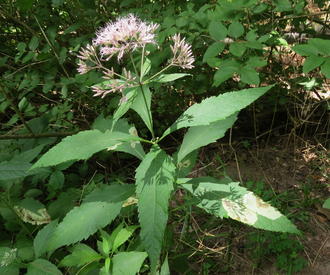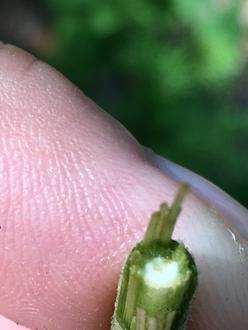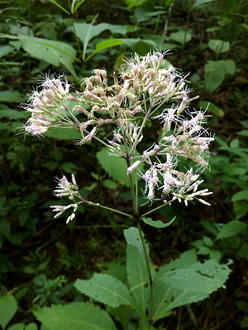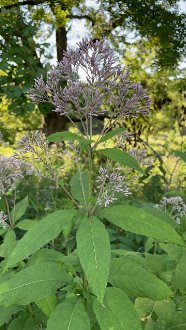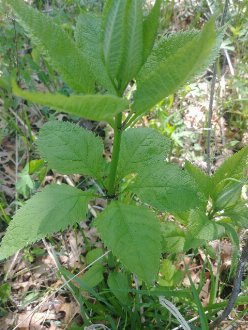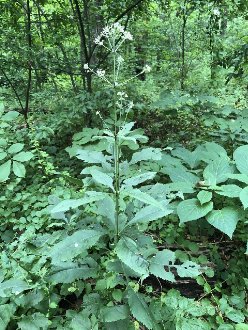Sweetscented Joe Pye Weed (Eutrochium purpureum (L.) E.E. Lamont)
Also known as purple Joe-Pye weed, Sweetscented Joe-Pye Weed, sweet Joe-Pye weed, sweet Joe Pye weed, gravel root; also classified as Eupatorium purpureum, Cunigunda purpurea, Eupatoriadelphus purpureus.
↑Summary
A tall perennial of partly-shaded areas, preferring drier and shadier conditions than other Eutrochium species.
↑Range - Expand
| Legend | Color |
| Native | |
| Native or Not Present |
This tentative map is based on our own research. It may have limited data on Canada and/or Mexico, and there is some subjectivity in our assignment of plants as introduced vs. expanded. Read more in this blog post.
Although this plant occurs somewhere in each of these regions, it may only occur in a small part of some or all of them.
↑Description & Identification
This species is similar to other Joe Pye (Eutrochium) species, and can hybridize with all of them, so it may not be possible to identify all individuals.
This species tends to grow to about 6.5 feet in height; the stem is usually green between nodes, contrasting with bold dark purple at nodes; the purple usually extends a bit above and below each node as well as a bit onto the stalk of each leaf. Stems of mature plants usually lack spots or a waxy coating but these features may occur on the early growth of some plants in spring, and some southern populations have spotted stems. The stem is usually not hollow, often containing a solid white pith, but when it is hollow the cavity is smaller than on E. fistulosum. The inflorescence tends to be round-topped and sparser and more open than other Eutrochium species, perhaps reflecting its shadier habitat. There are usually 4-8 florets per flowerhead, and the inflorescence is usually pale pink in color.
The leaves usually occur in whorls of 3-4, occasionally 5, and the leaves lack a triple-veined appearance instead having many small side-veins; the leaves are often broader and smoother textured, with less visibly-textured veins than other Eutrochium species. Except in periods of drought, when lower leaves die, the foliage is usually retained to low down on the plant throughout the growing season.
↑Similar Plants
↑Habitat
Found in open woodlands, forest edges and clearings, thickets, savannas, and partly-shaded floodplains. Prefers light shade from an open canopy. We could not find material verifying the soil tolerances of this species in the wild, but it likely tolerates a range of soil conditions, with best growth in fertile, loamy soils. Gardening sites note it can tolerate clay soils if moderately well-drained, rocky or gravely soils, as well as sandy soils if sufficiently moist, and that it tolerates alkaline, neutral, and slightly acidic soil. There may be different local populations of this species that are adapted to different soil conditions; some areas have visually-distinguishable varieties that are often segregated by habitat.
This species is typically found in drier and more shaded conditions than the other Eutrochium species (other than the uncommon Eutrochium steelei.) Towards the west of its range, where its growth is more moisture-limited, it is mostly found in moist to mesic, but still well-drained, conditions, whereas in much of its range is more common in mesic to slightly dry conditions, but can still be found in well-drained portions of floodplains.
This species often thrives in habitats degraded by humans, such as small forest fragments, where it benefits from higher light availability. It can persist long-term where conditions keep the canopy open, but will be eliminated under a dense, closed forest canopy.
We could not find information on the prevalence of fire in the habitats where this species occurs, but its life cycle and habitat preferences suggest some adaptation to fire. Its preference for disturbed habitats, open forests, and savannas suggest it may occur on sites which have experienced a fire at some point in the recent past, and its wind-dispersed seeds could help it colonize burned sites. However it is usually absent from the driest sites most prone to regular, severe fires.
↑Life Cycle
Eutrochium purpureum is an herbaceous perennial with a clumping habit. Details of its life-cycle are not well-documented.
Plants do not usually bloom in their first year.
Mature plants flower July-September, and seed ripens in autumn; seed is dispersed primarily by wind. Seeds germinate in spring following a period of cold dormancy, but we could not find information on typical conditions for germination and establishment in the wild. Based on advice from gardening sites, germination is best when the seeds are protected by a thin layer of litter, reflecting the timing of seed release, usually earlier than the fall of all leaves in the partly-forested environments where it occurs.
Over time, individual plants growing on favorable sites will grow in extent and send up multiple stems, but it does not usually spread long distances vegetatively. Large colonies may be formed by different individuals established by seed.
In the absence of disturbance, it is usually eliminated from a site as the canopy closes and level of shade increases. We could not find documentation of the typical lifespan of individual plants.
↑Faunal Associations
The flowers attract a variety of pollinators, including long-tongued bees (bumblebees, Melissodes bees, and leafcutter bees), butterflies, skippers, and moths.
The plant is also eaten by the larvae of several moth species, including the eupatorium borer moth (Carmenta bassiformis), which eats numerous other closely-related plants, the red groundling moth (Perigea xanthioides), which also eats Vernonia sp., the three-lined flower moth (Schinia trifascia), which eats various plants of the Eupatorieae tribe, the polyphagous ruby tiger moth (Phragmatobia fuliginosa), the polyphagous common eupithecia (Eupithecia miserulata) and the morning-glory plume moth (Emmelina monodactyla), which primarily eats species of other families.
The larvae of the flies Calycomyza flavinotum, Liriomyza pusilla and Phytobia allecta mine the leaves of this and related species, the Joe-Pye Blossum Midge (Dasineura purpurea) forms galls on the flowers of this and related plants, and the warty leaf beetle Exema dispar eats this plant. The aphid Uroleucon eupatoricolens and the treehopper Entylia bactriana feed on the sap.
Deer may browse this plant's foliage but usually do not consume much because of toxins.
The seeds are eaten by birds, including the American goldfinch (Spinus tristis) which eats the seeds while still on the plant, and the dark-eyed junco (Junco hyemalis) and swamp sparrow (Melospiza georgiana) which eat the fallen seeds in winter. The large number of insects supported by this plant also makes it indirectly support insectivorous birds such as the Carolina Wren (Thryothorus ludovicianus).
This species is often among the tallest herbaceous plants in its environment, and often retains dense foliage even quite low to the ground, which makes it an important contributor to the structure of the ecosystems, and important as cover for a variety of animals.
↑Uses
This plant is widely used in landscaping, and is becoming increasingly popular. It is valued for its ability to thrive in the typical conditions in a partly-shaded garden, its attractive foliage and flowers, and its tendency to attract large butterflies, but its use is limited by its large maximum height. Some cultivars exist.
The plant is also used for medicinal purposes, where it is primarily called by the name gravel root and sometimes kidney root, reflecting its traditional use for kidney stones and other urinary tract issues. As a medicinal plant its use is not generally considered safe: it contains compounds that can cause liver damage, vomiting, cancer, and birth defects.
↑Related Plants
All Eutrochium species are closely related; this species has a broad range overlapping with all four others, and is known to hybridize with each of them where their ranges overlap.
↑Notes
This plant has escaped cultivation in Norway, New Zealand, and Switzerland, and may become an invasive species in these and other areas if its planting continues. Due to its prolific seeding, wind-dispersed seeds, and ability to thrive in disturbed habitats in a range of conditions, it is best to avoid planting it anywhere outside its native range, especially outside North America where no Eutrochium species occur, and thus none of the insects that specialize on these plants are found.
↑Links & External Resources
• Eutrochium purpureum (Sweet Joe-Pye Weed) | Illinois Wildflowers (About This Site)
• Eutrochium purpureum (Sweetscented Joe Pye Weed) | USDA PLANTS Database (About This Site)
• Eutrochium purpureum | Go Botany (About This Site)
• Eutrochium purpureum (Joe Pye Weed) | Missouri Botanical Garden Plant Finder (About This Site)
• Sweet Joe-Pye-Weed | iNaturalist (About This Site)
• Eutrochium purpureum | Biota of North America Project (BONAP) (About This Site)
• Eutrochium purpureum | Flora of North America (About This Site)
• Eutrochium purpureum | Missouri Plants (About This Site)
• Sweet-scented Joe Pye Weed | Maryland Biodiversity Project (About This Site)
• Eutrochium purpureum (Sweet Scented Joe Pye Weed) | Minnesota Wildflowers (About This Site)
• Eutrochium purpureum (Linnaeus) E.E. Lamont var. purpureum (Sweet-scented Joe-pye-weed, Sweet Joe-pye-weed, Purple Joe-pye-weed) | Digital Atlas of the Virginia Flora (About This Site)




